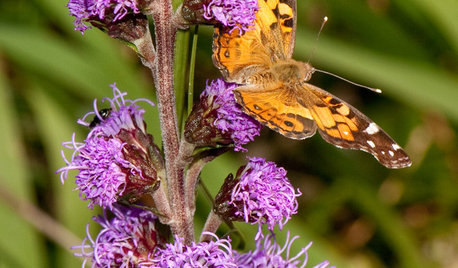Caterpillar ID, Nevada
todancewithwolves
16 years ago
Related Stories

VACATION HOMESHouzz Tour: Snowy White Makeover for a Lake Tahoe Condo
Traditional alpine decor gets the boot in favor of a modern Scandinavian look in this Sierra Nevada getaway
Full Story
GREEN BUILDINGHouzz Tour: The Goal? A Big Impression but a Small Footprint
This family home in Nevada City, California, embraces the environment with enthusiasm and style
Full Story
GARDENING GUIDESGreat Design Plant: Eriogonum Nudum, a Summer Oasis for Pollinators
Naked buckwheat is a bee and butterfly magnet with an easy nature, a tough constitution and profuse pom-pom flowers in summer
Full Story
GARDENING GUIDESAmerican Lady Butterflies Add Delight to Summer Gardens
Provide native nectar and larval host plants to welcome these migratory butterflies
Full Story
GARDENING GUIDESGreat Design Plant: Little Bluestem Goes Above and Beyond
It thrives in poor soil and provides food and shelter for wildlife. Plus, Schizachyrium scoparium is just a darn pretty native grass
Full Story
MOST POPULARMeet a Lawn Alternative That Works Wonders
Carex can replace turfgrass in any spot, is low maintenance and adjusts easily. Add its good looks and you’ve got a ground cover winner
Full Story
FLOWERS AND PLANTSHelp Monarchs and Other Butterflies by Planting Common Milkweed
Summer-blooming Asclepias syriaca is an important larval host plant for the monarch butterfly and attracts a number of pollinating insects
Full Story
GARDENING GUIDESGreat Design Plant: Asclepias Incarnata for a Butterfly Garden
Beautiful swamp milkweed makes it easy to help monarchs and other pollinators in eastern U.S. gardens
Full Story
GARDENING GUIDESHow I Learned to Be an Imperfect Gardener
Letting go can lead to a deeper level of gardening and a richer relationship with the landscape. Here's how one nature lover did it
Full StoryMore Discussions








ladobe
todancewithwolvesOriginal Author
Related Professionals
Owings Mills Landscape Architects & Landscape Designers · Canton Landscape Contractors · Nashua Landscape Contractors · North Haven Landscape Contractors · Paso Robles Landscape Contractors · Royal Oak Landscape Contractors · Waipahu Landscape Contractors · Clearfield Landscape Contractors · Leander Fence Contractors · Maryland City Fence Contractors · Salida Fence Contractors · Wake Forest Fence Contractors · Milwaukie Fence Contractors · Boulder City Fence Contractors · Coconut Grove Window ContractorstodancewithwolvesOriginal Author
todancewithwolvesOriginal Author
ladobe
todancewithwolvesOriginal Author
todancewithwolvesOriginal Author
ladobe
todancewithwolvesOriginal Author
susanlynne48